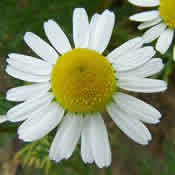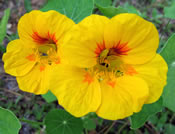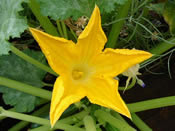Trendy restaurants sprinkle them on salads or use them to garnish deserts. Gardeners can do the same by growing some edible flowers. Most are easy to cultivate and have multiple uses in the kitchen. Be forewarned, says Rosalind Creasy, author of "Edible Flower Gardening," not all flowers are edible, and some like oleander are poisonous, so stick with tried-and-true options like those below. If you have allergies or asthma, begin by consuming only small quantities.
|
Calendula (Calendula officinalis) - While not the most flavorful, the fresh golden petals of this old-fashioned annual brighten salads or omelets. This Mediterranean native likes full sun and moderate water. |
|
Chamomile (Matricaria recutita) - The petals of chamomile’s dainty daisy flowers add a pineapple flavor to hot or iced teas. Dried, they make the classic chamomile herbal tea. This attractive plant with ferny foliage prefers full sun.
|
|
Borage (Borago officinalis) - Borage’s starry petals have a cucumber flavor, making them an ideal salad garnish. Remove the fuzzy stamens before adding to your favorite greens. Grows to 3 feet tall and tolerates poor soil and low water. Full sun.
|
|
Nasturtium (Tropaeolum majus) - A chef favorite for their hot color and spicy bite, nasturtium blossoms and leaves can be chopped and tossed “like confetti,” Creasy says, over salads. Also use them to flavor butters, oils, vinegars and soft cheeses. This spring bloomer likes sun to part shade and regular water. Reseeds vigorously.
|
|
Squash blossoms (Curcurbita spp.) - Sweet squash blossoms are a farmer’s market favorite among cooks who stuff them with meat or cheese mixtures. If you’re growing zucchini, reduce your crop by harvesting blossoms. Remove stamens and pistils before using. Plant this warm-season vegetable now.
|
|
Johnny-Jump-Ups, Pansies and Violets (Viola cornuta, V. tricolor, V. wittrokiana and V. odurata) - Pretty single or multi-colored flowers in shades of blue and purple sparkle in salads. Ambitious cooks can candy blossoms to accent desserts. Plant in early winter for spring bloom and give regular water.
|





